An Brief Overview of 12th Century Clothing
(Or What to Wear to the Marshal Event)
By Mistress Magdalena vander Meere (Nancee Beattie)
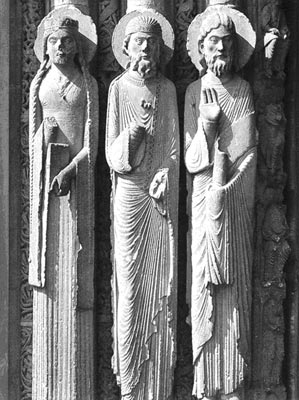 Fashion in Europe during the latter half of the twelfth century took a distinctive turn. Tight-fitting in the torso, and flared at the cuffs and hems, it was both more revealing and more flowing than previous styles. While one could get away with loose-fitting, belted tunics, the more tailored look was haute couture.
Fashion in Europe during the latter half of the twelfth century took a distinctive turn. Tight-fitting in the torso, and flared at the cuffs and hems, it was both more revealing and more flowing than previous styles. While one could get away with loose-fitting, belted tunics, the more tailored look was haute couture.
In order to achieve this tightness across the torso, garments had to be open along the back or sides and laced up once the wearer had them on. The construction of these garments, it seems, was still very geometric. From many of the sculptures and manuscripts, it looks as though the waist was pulled tight and wrinkled. This very well could be the result of inexact fitting of the garment, a technology that had only begun to develop. However, this wrinkling at the waist may well have been sought after and intentional. Either way, it does seem common to the fashions of the time.
The flared cuffs were also part of high style, and varied in both width and length. Some cuffs were quite long, even so to drag the ground, while some were little more than trumpet-shaping of the lower sleeve. Men were more likely to wear the trumpet shape, and women the long flowing cuff (often called a maunch). Men´s gowns often had close sleeves not flared at all. In the cases of the close cuffs, they usually have a contrasting trim at the wrist, and may have been embroidered or otherwise embellished.
As continues to be true throughout our period, people dressed in layers. The three visible layers can be called the shirt, the gown and the mantle.
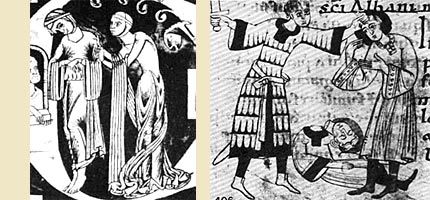
The shirt is a simple tunic, probably of lightweight linen or silk, with no body shaping and closer fitted sleeves—not so close that they would need fastenings to take on or off, but not at all flowing. These sleeves would be full-length to the wrist. The length of the shirt would depend on the wearer. Women would wear a long shirt—to the floor. A man could wear a long shirt, but was often seen with one as short as knee-length. The man´s legs should be covered with leg wraps or hosen. The neckline of the shirt would be a close-set key-hole closed with a pin.
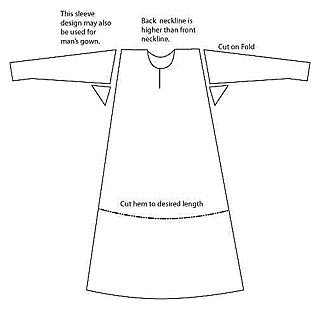 Click here for larger version
Click here for larger version
The gown goes over the shirt and had a big flared hem and often wide cuffs. It would probably be made of light wool or silk. The fabric, to get the proper affect, should be soft and draping. The flow of the hemline would be achieved through the addition of gores in the side of the garment. The neckline of the gown could either be a keyhole, similar to the shirt, or could be more of a V-neck, with an external yoke of some contrasting color. The cuffs and necklines of these gowns are a perfect place for embroidery or other embellishment.
A woman´s gown would be floor-length. The cuffs of the women´s gown, as stated before, would be exaggerated, even pendulous. To get the proper effect for the woman´s gown, the torso of the garment should be fairly fitted to the waist. Use the triangular underarm gussets to expand the torso for the chest. This does not seem to be an uplifting garment, but more of a binding, flattening garment, but you should structure yours for your own comfort. Make the length of the torso four to eight inches longer than needed, and when you lace into it, the fabric will gather up around the middle and form the wrinkles seen in contemporary images. The bigger the gores, the wider the skirt, so use as much fabric as you can spare.
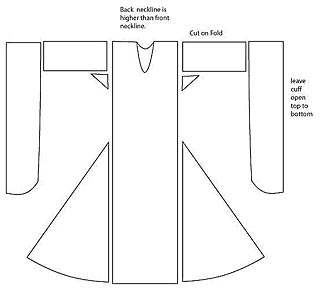 Click here for larger version
Click here for larger version
A man´s gown would not greatly exceed the length of his shirt. Men´s garments could be tightly laced like women´s garments, but some of the images look like they were looser tunics, belted, but with the trumpet sleeves. A man´s gown could also be slit from the hem to hip to allow for horseback riding. These slits are called vents.
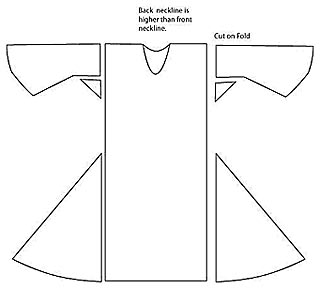 Click here for larger version
Click here for larger version
The top layer was the mantle. This was a cloak or cape to keep warm. It could be a large rectangle pinned at the shoulder, or a semi-circle pinned at the throat. It would likely have been made of wool, but could be lined with silk or linen.
These garments were, in some ways, ahead of their time. Not long after this period, fashions returned to a looser style. It is believed that the church highly disapproved of such revealing garments. However, a few hundred years later tight tailoring returned and has been with us ever since.
![]() Marshal – Flower of Chivalry • Coming to Three Rivers Memorial Day Weekend 2009
Marshal – Flower of Chivalry • Coming to Three Rivers Memorial Day Weekend 2009

